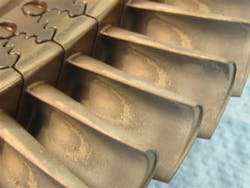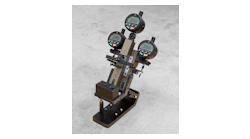Sulfidation: Turbine Blade Corrosion
Deep inside every turbine engine there’s a conflict occurring: Sulfur versus contaminants in engine intake air such as sodium (salt), air pollution, soot, volcanic ash, agricultural chemicals, and other airborne particles.
When the turbine’s scorching heat joins the mix, it results in a corrosive weapon that eats away at the clean, efficient surfaces of compressor turbine blades. There are ways to minimize the collateral damage, (e.g. delay expensive part replacement or avoid massive engine failures). The name of this conflict is sulfidation.
Causes
Every technician knows the old saying “rust never sleeps” and has witnessed first hand the results of the oxidation that takes place when ferrous-based metals (e.g. iron)come in contact with moisture-laden air. Protective coatings and air drying techniques minimize and impede the corrosion process but cannot stop it completely. So it is with sulfidation (e.g. sulfur corrosion).
Every turbine engine uses fuel contaminated with sulfur, that when burned at high temperatures, emits varying amounts of sodium sulfate gas. Sulfidation is accelerated by the presense of catalysts. Just as there is no way to dry the air completely to eliminate rust-producing moisture, no one has yet built an effective filter to purify turbine engine intake air completely. If the aircraft operates near oceans, industrial complexes, cities, or volcanic regions, the engine’s intake system provides even stronger allies to link up with the sulfur waiting in the combustion chamber. The hot section becomes the battlefield where sulfidation begins. Once the sulfidation attack successfully penetrates a CT blade’s protective layer and reaches the base metal, there is no reversing the process.
For decades, turbine designers and engineers have come up with effective defenses for their turbine blades. These include using strong materials capable of withstanding high temperatures such as nickel and cobalt base metal alloys. In addition, several very effective defensive coatings have been added as “armor” for the blades. These coatings have included materials such as diffused aluminide and silicone aluminide (Sermaloy J). Each coating has its own particular advantages and disadvantages. The research and testing continue to search for that perfect alliance of base metal and protective coating that can effectively fight off sulfidation while not sacrificing protection against the even higher temperature oxidation forces. The goal is to try to extend operating intervals and to keep costs down — a daunting task. Different blade airfoil designs have also improved the defenses against both Type I sulfidation (1,500 F – 1,750 F; 825 C to 950 C) and Type II (1,300 F to 1,500 F; 700 C to 800 C).
Effects
Currently, there is no “magic weapon” in winning this war. There are only delaying actions that postpone what is considered “nonacceptable” damage before a turbine blade or allied part must be removed from service. It falls to the service technician and inspector to collect and analyze the intelligence data and physical evidence to determine the true condition and strategic plan of defense. There are four main levels of sulfidation attack that occur and must be evaluated at inspection time. It’s important for the technician/inspector to correctly determine which stage of attack is evident on each part.
STAGE 1: Light (or mild) sulfidation (initial coating deterioration) — The surface of the blade is slightly roughened with localized areas of breakdown evident on the protective coating and slight depletion of the base metal layer. None of this has, so far, reduced the mechanical integrity of the blade, but without treatment, the condition will eventually worsen. With this degree of damage, stripping and recoating the blade is effective.
STAGE 2: Failure of the protective layer (initial substrate corrosion) — Scale breakdown and surface roughness is more advanced than in Stage 1. Obvious depletion of the underlying alloy has begun. While mechanical integrity is maintained, there is no way to salvage this component back to original condition.
STAGE 3: Severe sulfidation — There is evidence of liquid sodium sulfate under the protective layer, along with a buildup of scale on the blade surface, and perhaps even on blade root and in shroud areas. Mechanical integrity is significantly affected and the sulfur corrosion will continue even with no further exposure to contamination attacks.
STAGE 4: Catastrophic attack — There is evidence of large blistering scale with deep penetration of the blade base metal, eventually leading to component failure unless the degraded parts are immediately removed from the engine. Structural integrity is lost.
Minimizing the effects
While there are only limited things a pilot or mechanic can do to prevent the sulfidation attacks on the turbines, just being aware of the turbine’s vulnerability can justify shortening maintenance intervals. Shorter maintenance intervals are more costly, but the long-term cost savings more than offset that expense. Pratt & Whitney Canada (P&WC) recommends: performance recovery wash, desalination/desulfidation wash to slow down corrosion effects and borescope inspection to monitor engine condition. Since sodium (salt) is a major contributor to sulfidation, if the aircraft is operated from or near (within 20 miles inland of) a saltwater source, the likelihood for severe damage is greatly increased. The same is true if the aircraft is operated near high pollution risk areas. Since desalination and desulfidation wash use only clean water, it is nearly impossible to damage the engine by washing the engine too often. When in doubt, perform desalination and desulfidation washes more frequently.
A common myth is that changing engine operating temperatures can alleviate sulfidation problems. The truth is that changing engine operating temperatures only moves the location within the turbine area where sulfidation occurs. Lowering operating temperatures moves the sulfidation to the CT vane ring, whereas increasing the operating temperatures moves the sulfidation to the CT shroud segments and the power turbine vane ring. For this reason, flight crews are not encouraged to make any changes in the operating regime of the aircraft to decrease sulfidation. However, they should be aware that periods of high temperature during start-up, and high temperature/high power conditions during take-off and cruise all contribute to “premature hot engine distress.”
Flight crews should use “Engine Condition Trend Monitoring” procedures if available to record flight performance data that will help technicians during inspections.
Technicians should inspect other parts of the “gas path” including the intake, fuel, and exhaust systems that can also contribute to overtemperature conditions in the hot section. Installation of intake and exhaust covers while the aircraft is parked for extended periods, especially in high wind environments, is highly recommended. In addition to intake air quality, fuel quality and proper delivery functions are important to maintain recommended engine temperatures and avoid “gas path contamination.” Thorough and regular inspections of fuel quality, fuel storage, and delivery equipment, as well as fuel nozzle efficiency and fuel pump filter condition, help decrease the potential for contributing conditions to sulfidation. Fuel handling is a complex process. If you are not familiar with proper fuel handling techniques, purchase fuel from sources that are experts in proper fuel handling techniques.
Battlefield support
Besides periodic inspections, technicians can perform motoring washes to clean and desalinate the compressor section of the engine. Performance recovery wash uses cleaning chemicals in the compressor with OEM-approved products like R-MC engine cleaner followed by clean water wash in the compressor and turbine. Desalination wash uses clean water in both the compressor and turbine to remove salt, air pollution, agricultural chemicals, and sulfur. In extreme cases, daily washes (or even after each flight) may be necessary when the aircraft is operated in high-risk areas.
It is important to check the most current procedures recommended by the engine manufacturer to determine whether a motoring wash (simply using the starting motor to rotate the engine) or a running wash (engine started up and running) should be performed. In general, motoring washes are now considered preferable to running washes. Either way, be sure to use the cleanest water available. While some manufacturers say that “any water safe to drink” can be used for washes, others recommend deionized (distilled or demineralized) water only. In addition, chemicals mixed with the water for cleaning the engine (i.e. performance recovery wash) vary relating to their corrosive, hazardous waste, and biodegradable characteristics. Regulations regarding their use and disposal in various environments vary from state to state and country to country.
Also, technicians should be aware that the more pure the wash water is, the “hungrier” it is for attracting the very contaminants one is trying to extract from the engine. Therefore, stainless-steel storage tanks or other metal containers with approved epoxy coatings are recommended. Glass and fiberglass containers should be avoided. Polyethylene containers are acceptable only if they are of the nonpigmented, detergent-grade quality. Even immersing one’s finger in deionized or demineralized water can raise the specific conductance tenfold and thereby reduce its effectiveness.
Be sure to consult the engine manufacturer’s recommendation for types of chemicals, pressure equipment, flow rates, temperatures, and other safety-related procedures.
When it is time to repair or replace hot section parts, install alternative parts that have a higher resistance to sulfidation. Sermaloy J (silicon aluminide) has been proven to either double or sometimes quadruple the resistance to sulfidation. Diffused aluminide has been shown to have a higher resistance to oxidation at elevated temperatures. When selecting new parts during hot section repair/overhaul it is important to be aware of the sulfidation history (or lack thereof) of your engine. Traditionally P&WC has provided hot section parts with diffused aluminide coatings. It is important to select the coatings that are best equipped to address your particular operating environment.



